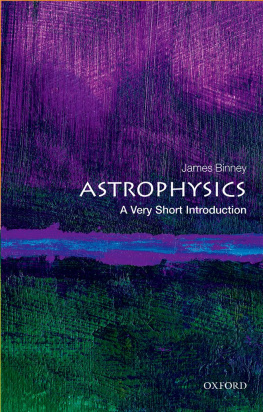James MacDonald - Structure and Evolution of Single Stars: An Introduction
Here you can read online James MacDonald - Structure and Evolution of Single Stars: An Introduction full text of the book (entire story) in english for free. Download pdf and epub, get meaning, cover and reviews about this ebook. year: 2015, publisher: Morgan & Claypool Publishers, genre: Children. Description of the work, (preface) as well as reviews are available. Best literature library LitArk.com created for fans of good reading and offers a wide selection of genres:
Romance novel
Science fiction
Adventure
Detective
Science
History
Home and family
Prose
Art
Politics
Computer
Non-fiction
Religion
Business
Children
Humor
Choose a favorite category and find really read worthwhile books. Enjoy immersion in the world of imagination, feel the emotions of the characters or learn something new for yourself, make an fascinating discovery.
- Book:Structure and Evolution of Single Stars: An Introduction
- Author:
- Publisher:Morgan & Claypool Publishers
- Genre:
- Year:2015
- Rating:5 / 5
- Favourites:Add to favourites
- Your mark:
- 100
- 1
- 2
- 3
- 4
- 5
Structure and Evolution of Single Stars: An Introduction: summary, description and annotation
We offer to read an annotation, description, summary or preface (depends on what the author of the book "Structure and Evolution of Single Stars: An Introduction" wrote himself). If you haven't found the necessary information about the book — write in the comments, we will try to find it.
James MacDonald: author's other books
Who wrote Structure and Evolution of Single Stars: An Introduction? Find out the surname, the name of the author of the book and a list of all author's works by series.
Structure and Evolution of Single Stars: An Introduction — read online for free the complete book (whole text) full work
Below is the text of the book, divided by pages. System saving the place of the last page read, allows you to conveniently read the book "Structure and Evolution of Single Stars: An Introduction" online for free, without having to search again every time where you left off. Put a bookmark, and you can go to the page where you finished reading at any time.
Font size:
Interval:
Bookmark:

12.1 Pair annihilation neutrino process (e++e+)
12.2 Plasma neutrino process (plasmon+)
12.3 Photo-neutrino process (+ee++)
Structure and Evolution
of Single Stars
An introduction
James MacDonald
University of Delaware
Morgan & Claypool Publishers
Copyright 2015 Morgan & Claypool Publishers
All rights reserved. No part of this publication may be reproduced, stored in a retrieval system or transmitted in any form or by any means, electronic, mechanical, photocopying, recording or otherwise, without the prior permission of the publisher, or as expressly permitted by law or under terms agreed with the appropriate rights organization. Multiple copying is permitted in accordance with the terms of licences issued by the Copyright Licensing Agency, the Copyright Clearance Centre and other reproduction rights organisations.
Rights & Permissions
To obtain permission to re-use copyrighted material from Morgan & Claypool Publishers, please contact .
ISBN 978-1-6817-4105-5 (ebook)
ISBN 978-1-6817-4041-6 (print)
ISBN 978-1-6817-4233-5 (mobi)
DOI 10.1088/978-1-6817-4105-5
Version: 20151101
IOP Concise Physics
ISSN 2053-2571 (online)
ISSN 2054-7307 (print)
A Morgan & Claypool publication as part of IOP Concise Physics
Published by Morgan & Claypool Publishers, 40 Oak Drive, San Rafael, CA, 94903, USA
IOP Publishing, Temple Circus, Temple Way, Bristol BS1 6HG, UK
To my stellar wife, Ruth, and children, Claire, Madolyn and Elena.
This book is an outgrowth of the notes for my course on stellar astrophysics which I have taught at the University of Delaware on a regular basis over the past 15 years. It is geared towards undergraduate students in their senior year and graduate students beginning their astronomical studies. I assume that students are comfortable with material from classical mechanics, quantum mechanics, statistical physics, and thermodynamics.
I make significant use of figures based on computations of stellar structure and evolution using my version of what is often referred to as the Eggleton code and I am grateful to my PhD adviser, Peter P Eggleton, for providing me with an early version of his easily adapted code. For students who wish to perform their own stellar evolution computations I recommend that they use the modern and efficient Modules for Experiments in Stellar Astrophysics (MESA) code written by Bill Paxton and colleagues. This code is currently downloadable from http://mesa.sourceforge.net/. A benefit of using this code is that it is well supported through a MESA-users mailing list and the MESA community portal.
I wish to thank Dr Douglas Gough for introducing me to the fascinating topic of stellar evolution, Dr Peter Eggleton for providing me with his flexible stellar evolution code, and all my colleagues who over the years have added to my knowledge and experience, and in particular Drs Icko Iben, James Truran, and Sumner Starrfield.
James MacDonald

The author received his PhD in Astronomy from Cambridge University in 1979. Following postdoctoral positions at the Universities of Sussex and Illinois and Arizona State University, he joined the University of Delaware in 1985 where he is now a Professor of Physics and Astronomy. His scientific expertise is the study of the structure and evolution of stars. Recent work has focused on low mass main sequence stars and brown dwarfs. He has published over 80 papers in peer-reviewed journals.
IOP Concise Physics
Structure and Evolution of Single Stars
An introduction
James MacDonald
One of the most difficult tasks in astronomy is finding accurate distances to objects. Distances to nearby stars can be found by trigonometric parallax. This method is shown schematically in figure .

Figure 1.1. Schematic showing the definition of the parallax, , for a star a distance, d, from the Sun.
As the Earth orbits the Sun, a nearby star will appear to move relative to the background of distant stars. This allows measurement of the parallax, . The parallax of Proxima Centauri, the nearest star to the Sun, is 0.762 arc seconds. Since this, the largest parallax, is a very small angle, an accurate approximation in finding the distance to the star, d, is to replace tan by . The distance to the star, d, is then given by
d=1, (1.1)
where the unit of d is the parsec (pc, parallax seconds) and is measured in arc seconds.
In terms of more familiar units, 1 pc = 3.086 1013 km = 3.262 lyr. The distance to Proxima Centauri is then 1/0.762 pc = 1.31 pc = 4.28 lyr = 4.05 1013 km.
The trigonometric parallaxes of a large number of stars were measured with the Hipparcos satellite (Hipparcos is short for High Precision Parallax Collecting Satellite). The smallest measured parallax was about 1 milli-arc second, corresponding to a distance of 1 kiloparsec (1 kpc). The Gaia satellite, which was launched in December 2013, will measure the positions, distances and radial velocities of about one billion stars in our Galaxy and its satellite galaxies.
Once we know the distance to a star we can convert the measured flux, i.e. the energy in some wavelength interval crossing unit area of a detector in unit time, to absolute luminosity, i.e. the energy emitted by the star in the same wavelength interval in unit time. (Alas, this is not so simple in practice because material along the line of sight to the star can scatter or absorb the starlight. A correction for interstellar extinction must then be made.)
The brightness of stars is usually measured on the magnitude scale (which originated with the ancient Greek astronomer Hipparchus). The apparent magnitude, m, of a star is related to the measured flux, f, in a particular wavelength interval (or band) by
m=2.5logff0, (1.2)
where f0 is a constant specific to the particular band. Clearly f0 is equal to the flux of a star of zero magnitude. The absolute magnitude, M, of a star is defined to be the magnitude it would have if it were at a distance of 10 pc and there were no interstellar extinction. This is related to m and d, the distance to the star in parsecs, by
M=m+55logdA, (1.3)
where A is the correction for interstellar extinction in magnitudes.
The bolometric magnitude is a measure of the total radiation from the star emitted over all wavelengths. The luminosity of a star is the total energy emitted (in electromagnetic radiation) in unit time. The luminosity, L, of a star and its absolute bolometric magnitude, Mbol, are related by
Mbol=4.7552.5logLL, (1.4)
where L is the luminosity of the Sun. A recent measurement of the solar luminosity [] is 3.827 1033 erg s1.
The measurement of stellar radiation using filters is called multi-color photometry. There are a number of photometric systems in use. The standard system [] makes use of three standard (transmission) filters called U, B, and V, which stand for ultra-violet, blue, and visual. The effective wavelengths of these filters are 365, 440, and 550 nm, respectively. The apparent magnitudes of a star measured with these filters are usually denoted by
Font size:
Interval:
Bookmark:
Similar books «Structure and Evolution of Single Stars: An Introduction»
Look at similar books to Structure and Evolution of Single Stars: An Introduction. We have selected literature similar in name and meaning in the hope of providing readers with more options to find new, interesting, not yet read works.
Discussion, reviews of the book Structure and Evolution of Single Stars: An Introduction and just readers' own opinions. Leave your comments, write what you think about the work, its meaning or the main characters. Specify what exactly you liked and what you didn't like, and why you think so.










